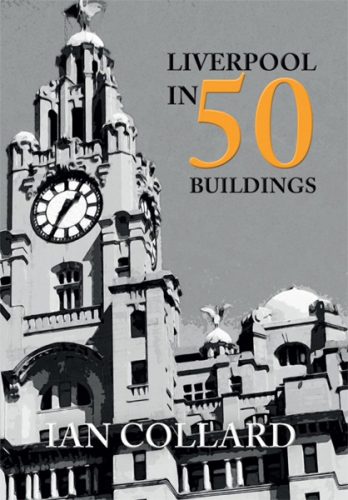By Ian Collard
Amberley Publishing
Reviewed by Tom Bottle
A bread and butter charge through Liverpool history and architecture in thumbnail descriptions of the city’s most famous and oldest buildings. A finger buffet for those normally happy to live in total ignorance of the built environment until they enter a landmark and suddenly demand facts and figures. That’s most of us. We can’t help it. It’s a human need.
A need that really kicks in when people hit their 50s, and gets progressively worse the older they get. A Godsend for the heritage and tourist industry, too, who capture all ages. Often against their will.
Reluctant and bored teenage Spanish backpackers, bewildered Middle Eastern ESOL (English as a second language) students, couples from Wolverhampton, and Dudley, who, to be fair, are as amazed as the rest of us that Liverpool is a great place to stroll around. Throw in RIBA Architecture tours and cruise ship day trippers and no one passing gets by without picking up some nugget.
Ian Collard prefers the traditional ‘Designed by E.W. Thornley’, ’40,000 sq ft’, ‘Rusticated entrance’ kind of nugget which pack ‘Liverpool in 50 Buildings’ – a solid, comprehensive nuts and bolts effort.
All guide books are porridge to get you through the day. Dipped into, after the initial burst, when the going gets tough, when sugar levels have dropped dangerously for lack of a date, historical fact or neoclassical feature. Invaluable as long as some other culture victim is doing the reading and telling you.
‘Liverpool in 50 Buildings’ is no better or worse than the millions of others in the genre where gathering data and photographs (actually good, up-to-date, large and clear) is seen as job done. The words seem to get in the way of the information, which is as it should be. Guide books are not novels, they should be read on the move, in situ, under that arch, from that view, touching the stone that changed the city.
Potted histories pile fact after fact inevitably lacking context and narrative but if you and your mate(s) can riff on this stuff an excellent time can be had by all. You will even remember some of it.
The author has done the spadework. If you’ve been around the block you will know a lot of it – the Bank of England building on Castle Street is “A masterpiece of Victorian architecture” (Pevsner); the overhead railway corroded and had to go in 1956; St. George’s ventilation shaft on the Strand is made of Portland stone and has sculptures designed by Edmund C. Thompson, assisted by G.T. Capstick – but on your own it will go in one ear and out the other.
Get the book, get some mates, and get the hell outa here.
